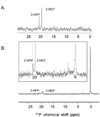Initial characterization of Fom3 from Streptomyces wedmorensis: The methyltransferase in fosfomycin biosynthesis
- PMID: 24370735
- PMCID: PMC4048823
- DOI: 10.1016/j.abb.2013.12.004
Initial characterization of Fom3 from Streptomyces wedmorensis: The methyltransferase in fosfomycin biosynthesis
Abstract
Fosfomycin is a broad-spectrum antibiotic that is useful against multi-drug resistant bacteria. Although its biosynthesis was first studied over 40 years ago, characterization of the penultimate methyl transfer reaction has eluded investigators. The enzyme believed to catalyze this reaction, Fom3, has been identified as a radical S-adenosyl-L-methionine (SAM) superfamily member. Radical SAM enzymes use SAM and a four-iron, four-sulfur ([4Fe-4S]) cluster to catalyze complex chemical transformations. Fom3 also belongs to a family of radical SAM enzymes that contain a putative cobalamin-binding motif, suggesting that it uses cobalamin for methylation. Here we describe the first biochemical characterization of Fom3 from Streptomyces wedmorensis. Since recombinant Fom3 is insoluble, we developed a successful refolding and iron-sulfur cluster reconstitution procedure. Spectroscopic analyses demonstrate that Fom3 binds a [4Fe-4S] cluster which undergoes a transition between a +2 "resting" state and a +1 active state characteristic of radical SAM enzymes. Site-directed mutagenesis of the cysteine residues in the radical SAM CxxxCxxC motif indicates that each residue is essential for functional cluster formation. We also provide preliminary evidence that Fom3 adds a methyl group to 2-hydroxyethylphosphonate (2-HEP) to form 2-hydroxypropylphosphonate (2-HPP) in an apparently SAM-, sodium dithionite-, and methylcobalamin-dependent manner.
Keywords: Cobalamin; Fosfomycin; Iron–sulfur; Methylation; Radical S-adenosyl-l-methionine (SAM); Streptomyces.
Copyright © 2013 Elsevier Inc. All rights reserved.
Figures






Similar articles
-
Stereospecific Radical-Mediated B12-Dependent Methyl Transfer by the Fosfomycin Biosynthesis Enzyme Fom3.Biochemistry. 2018 Aug 21;57(33):4967-4971. doi: 10.1021/acs.biochem.8b00616. Epub 2018 Jul 10. Biochemistry. 2018. PMID: 29969250 Free PMC article.
-
Characterization of the cobalamin-dependent radical S-adenosyl-l-methionine enzyme C-methyltransferase Fom3 in fosfomycin biosynthesis.Methods Enzymol. 2022;669:45-70. doi: 10.1016/bs.mie.2021.11.025. Epub 2021 Dec 31. Methods Enzymol. 2022. PMID: 35644180
-
Stereochemical and Mechanistic Investigation of the Reaction Catalyzed by Fom3 from Streptomyces fradiae, a Cobalamin-Dependent Radical S-Adenosylmethionine Methylase.Biochemistry. 2018 Aug 21;57(33):4972-4984. doi: 10.1021/acs.biochem.8b00693. Epub 2018 Aug 9. Biochemistry. 2018. PMID: 30036047 Free PMC article.
-
Radical-mediated enzymatic methylation: a tale of two SAMS.Acc Chem Res. 2012 Apr 17;45(4):555-64. doi: 10.1021/ar200202c. Epub 2011 Nov 18. Acc Chem Res. 2012. PMID: 22097883 Free PMC article. Review.
-
S-adenosylmethionine as an oxidant: the radical SAM superfamily.Trends Biochem Sci. 2007 Mar;32(3):101-10. doi: 10.1016/j.tibs.2007.01.002. Epub 2007 Feb 8. Trends Biochem Sci. 2007. PMID: 17291766 Review.
Cited by
-
Spectroscopic characterization and mechanistic investigation of P-methyl transfer by a radical SAM enzyme from the marine bacterium Shewanella denitrificans OS217.Biochim Biophys Acta. 2014 Dec;1844(12):2135-44. doi: 10.1016/j.bbapap.2014.09.009. Epub 2014 Sep 16. Biochim Biophys Acta. 2014. PMID: 25224746 Free PMC article.
-
Characterization of Two Late-Stage Enzymes Involved in Fosfomycin Biosynthesis in Pseudomonads.ACS Chem Biol. 2017 Feb 17;12(2):456-463. doi: 10.1021/acschembio.6b00939. Epub 2016 Dec 27. ACS Chem Biol. 2017. PMID: 27977135 Free PMC article.
-
Reaction Catalyzed by GenK, a Cobalamin-Dependent Radical S-Adenosyl-l-methionine Methyltransferase in the Biosynthetic Pathway of Gentamicin, Proceeds with Retention of Configuration.J Am Chem Soc. 2017 Nov 15;139(45):16084-16087. doi: 10.1021/jacs.7b09890. Epub 2017 Nov 7. J Am Chem Soc. 2017. PMID: 29091410 Free PMC article.
-
The B12-Radical SAM Enzyme PoyC Catalyzes Valine Cβ-Methylation during Polytheonamide Biosynthesis.J Am Chem Soc. 2016 Dec 7;138(48):15515-15518. doi: 10.1021/jacs.6b06697. Epub 2016 Nov 29. J Am Chem Soc. 2016. PMID: 27934015 Free PMC article.
-
New Insight into the Mechanism of Anaerobic Heme Degradation.Biochemistry. 2019 Nov 19;58(46):4641-4654. doi: 10.1021/acs.biochem.9b00841. Epub 2019 Nov 7. Biochemistry. 2019. PMID: 31652058 Free PMC article.
References
Publication types
MeSH terms
Substances
Grants and funding
LinkOut - more resources
Full Text Sources
Other Literature Sources

